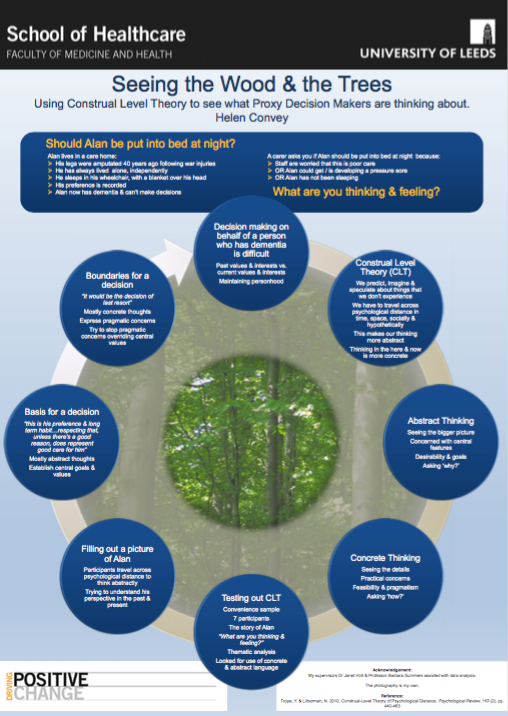Helen Convey. Lecturer in Adult Nursing, School of Healthcare, University of Leeds
 Individuals who are living with dementia and who lack decision making capacity require proxy decision makers to make decisions for them. Individuals may express their interests and desires through behaviour and verbal communication, however, memory loss results in a lack of psychological continuity between the past and the present self. When there is a conflict between the individual’s past values and interests and their present values and interests proxy decision makers encounter an ethical dilemma. The aim of this feasibility study was to explore the potential use of Construal Level Theory (CLT) as a way of analysing the thinking of proxy decision makers where this conflict occurs.
Individuals who are living with dementia and who lack decision making capacity require proxy decision makers to make decisions for them. Individuals may express their interests and desires through behaviour and verbal communication, however, memory loss results in a lack of psychological continuity between the past and the present self. When there is a conflict between the individual’s past values and interests and their present values and interests proxy decision makers encounter an ethical dilemma. The aim of this feasibility study was to explore the potential use of Construal Level Theory (CLT) as a way of analysing the thinking of proxy decision makers where this conflict occurs.
CLT (Liberman and Trope, 2014; Trope and Liberman, 2010) contends that people use mental construal to traverse psychological distance and to think about choices, alternatives and perspectives in different dimensions; temporal, spatial, social and hypothetical. In mental construal abstraction is used to move beyond direct, real experiences of the self, across psychological distance, to form a subjective view of an object or action. High-level construal is more abstract, central values receive attention. Low-level construal is concrete, detailed and contextualised.
Participants were given a scenario in one to one semi-structured interviews. They read the scenario and were asked what they were thinking and feeling. Thematic analysis was used to discover patterns of decision making. Participant responses within the themes were then analysed for abstractness of language using the Linguistic Category Model (Semin and Fiedler, 1991). Participants were found to travel across psychological distance to think abstractly about the person in the scenario. They used mostly abstract thinking to establish central values and beliefs and mostly concrete thinking to express pragmatic concerns. We concluded that CLT can be used to analyse the thinking of proxy decision makers.
Liberman, N. and Trope, Y. 2014. Traversing psychological distance. Trends in Cognitive Sciences. 18(7), pp.364-369.
Semin, G.R. and Fielder, K. 1991. The Linguistic Category Model, its Bases, Applications and Range. European Review of Social Psychology. 2(1), pp.1-30.
Trope, Y. and Liberman, N. 2010. Construal-Level Theory of Psychological Distance. Psychological review. 117(2), pp.440-463.
